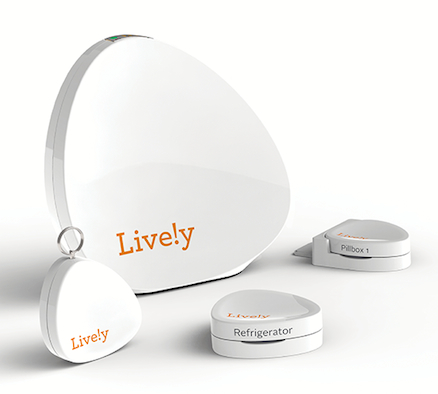 Aging-in-place startup Lively has put its home monitoring product in general release this week after landing $4.8 million in venture capital. Cambia Health Solutions led the Series A round, while Lively's seed investor Maveron also contributed, San Francisco-based Lively announced Tuesday.
Aging-in-place startup Lively has put its home monitoring product in general release this week after landing $4.8 million in venture capital. Cambia Health Solutions led the Series A round, while Lively's seed investor Maveron also contributed, San Francisco-based Lively announced Tuesday.
Lively, which combines stylish wireless sensors and a data-collection hub with biweekly printed mailers, is currently selling its system only through its website, but co-founder and CEO Iggy Fanlo said to expect the product to be available on Amazon.com and at major electronics retailers fairly soon. Longer-term marketing plans call for sales through TV shopping networks and perhaps high-end department stores, he added.
Lively attempted to raise $100,000 on crowdfunding site Kickstarter in the spring, but came up with just $15,177 in pledges, meaning it had to forfeit the money. While the company didn't come close to its goal, Fanlo said the campaign was immensely helpful with feedback. "The problem we're going to face is going to be our marketing message," Fanlo said.
He said the Kickstarter effort did draw a lot of interest. "We heard from 8-10 large entities from around the world [that] expressed interest in being distributors or resellers." Fanlo also reported hearing from AARP and other "industry experts."
The direct-to-consumer approach is risky in healthcare, an industry where third parties such as insurance companies pick up most of the tab. Fanlo told MobiHealthNews he believes Lively stands a chance as a DTC product because it boasts four things other home monitoring systems lack: affordability; design; ease of installation and use; and social connections.
Lively charges $149 plus a $19.95 monthly service fee for its base package, which measures medication compliance, food and drink intake and general activity outside the home. Other monitoring companies, including GE-Intel Care Innovations, Bosch Healthcare, Independa and the like market their systems mostly to providers and payers, but charge a lot more, Fanlo noted. "Our price point is such that you could argue those are institutional products," he said.
He believes sleek design gives the system an advantage in the consumer marketplace. Lively hired well-known product designer Fred Bould to style the Lively base station, which has no wires other than a power cord and no on-off switch, after AARP described other aging-in-place hardware as "big, beige and boring," Fanlo said.
Ease of installation and ease of use also were major considerations. "We've got to make it so it's totally DIY," Fanlo said. The Lively system features passive sensors with accelerometers and a base station with embedded cellular connectivity so customers do not have to link it to a Wi-Fi network or even have home Internet access at all.
One type of sensor goes on pill boxes, while another records when refrigerator or pantry doors are opened to indicate whether the senior is eating and drinking regularly. A key fob features a Bluetooth Low Energy transmitter that helps determine if the person being monitored has left the house. Sensors are placed on objects and secured with adhesive tape, not installed in walls or worn on the body.
For the social connection, Lively has turned to a very low-tech method called snail mail to create kind of an offline version of Facebook. Anyone the older user wants to hear from regularly receives an email each week asking to contribute photos and "status updates." Lively then produces and mails a customized photo booklet called LivelyGram twice a month.
"You have to have a social connection piece, and that's where LivelyGram was such a big winner [during pilot testing]," Fanlo said. "Users don't even need a computer," according to Fanlo.
According to Fanlo, the monitoring system and the LivelyGram together help ease family tension by delivering information both the elderly and their loved ones want. "Seniors don't want to be a burden to their kids and they don't want to be nagged," Fanlo said.
"We need to focus on social connections," Fanlo said. For this reason, he said, Lively added psychologist Laura Carstensen, founding director of the Stanford Center on Longevity, to its board of directors.
While other home health systems concentrate on monitoring chronic diseases, Lively is more interested in bringing people together. Fanlo said perhaps as many as 90 percent of seniors are in generally decent health, but simply feel isolated.
"It's about connection. It's about sharing activities. It's not about monitoring," Fanlo said.


















